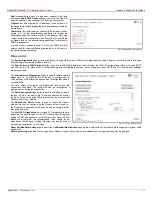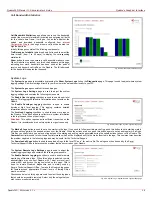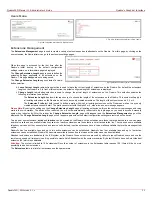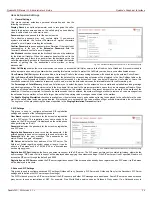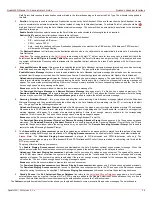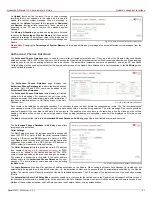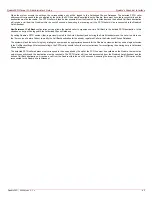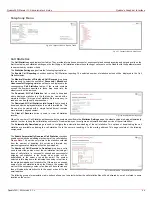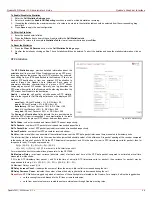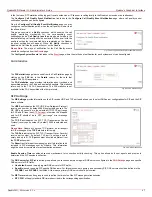
QuadroFXO Manual II: Administrator's Guide
Quadro's Graphical Interface
QuadroFXO; SW Version 5.1.x
36
•
Use External Voice Mail – enables the Voice Mail service for
the corresponding extension and is used to define a remote
Voice Mail Server as a location for the Voice Mails. In this
case recorded voice mails will be collected on the remote
server. Radio button selection enables a sub-group of
manipulation radio buttons:
•
If the remote Voice Mail Server is combined with the
SIP Proxy server, it is recommended to select Proxy
Controlled Mailbox Type. With this selection, SIP
proxy will keep the recorded voice mail on itself. When
extension accesses his mailbox by dialing *0, the call
will be redirected to the voice mailbox on the proxy
server.
Fig. II-66: Extensions Management - Edit Entry – Voice Mailbox Settings page
•
If the remote Voice Mail Server acts as a standalone location of voice mails, it is recommended to select Independent Mailbox Type.
With this selection, Quadro redirects the recorded voice mails to the defined remote Voice Mail server. When extension accesses his
mailbox by dialing *0, the call will be redirected to the remote voice mail server.
For each of these selections, it is required to enter the SIP URI of the Voice Mail Server where voice mails of the corresponding extension will
be collected.
Attention:
By choosing the Use External Voice Mail option, some internal voice mailbox services may become unavailable. Instead, the
services of the external voice mail server will become available to the user. Please consult with the external voice mail server administrator
before enabling this option.
The Transport Protocol for SIP messages radio buttons allow the transport protocol (UDP or TCP) for transmission of SIP messages to be
selected.
The Go to User Settings link is used to make a quick jump to the extension specific Extension's Main Menu page (see below Extension User’s
Menu).
Voice Mail Profiles
The Voice Mail Profiles page can be accessed by clicking on an extension link in the Extension Management table and then choosing Voice
Mail
Æ
Voice Mail Settings. The Profiles for Voice Mail Settings link on this page will lead you to the Voice Mail Profile page. The link is present
only when the administrator accesses this page and is hidden for the extension user.
The Voice Mail Profiles page is used to define and configure custom voice mail profiles.
The Voice Mail Profile is a group of most common Voice Mail Settings which can be saved under a specific name. This allows you to have several
versions of Voice Mail Settings configurations per extension.
Each Voice Mail Profile may have custom voice mail greeting, maximum voice mail duration, new voice mail notifications and Zero-Out settings. The
Voice Mail Profiles are activated based on the call routing rule used to establish a call. This is limited to the PBX-Voicemail type of calls used for a
direct access to the extension's voice mailbox. The Voice Mail Profile name should be provided in the
when defining a PBX-
Voicemail routing rule. When the rule is used, caller accesses the called extension's mailbox with the settings configured in the corresponding voice
mail profile.
With this service, you can pre-configure several versions of
Voice Mail Settings and save them as Voice Mail Profiles.
For example, if a call is originated from the PSTN network to
the corresponding extension's voice mailbox, the greeting
message can tell the caller: "You have reached the ...
company, please leave a message." and the maximum
voice mail duration is configured to 15 minutes. This voice
mail profile can be saved as "ForPSTN" and its name should
be defined in the routing rule responsible for incoming PSTN
calls distribution. In parallel to this voice mail profile, there
can be another profile designed for internal PBX calls. It will
play the following voice mail greeting: "Hi, you have reached
Mike's voice mailbox, please drop me a message and I shall
call you back.", the maximum voice mail duration is 5
minutes and there is a Zero-Out feature configured to call
Mike's cellular phone. This voice mail profile can be saved
as "ForPBX" and its name should be defined in the routing
rule responsible for PBX calls distribution to the local
extensions. When the first routing rule is used and the call
Fig. II-67: Extensions Management - Edit Entry – License Settings page
reaches the extension that has the corresponding voice mail profile, the settings of the ForPSTN voice mail profile will be activated. For the second
routing rule, when the call reaches Mike's voice mailbox, the settings of the ForPBX voice mail profile will be activated.






